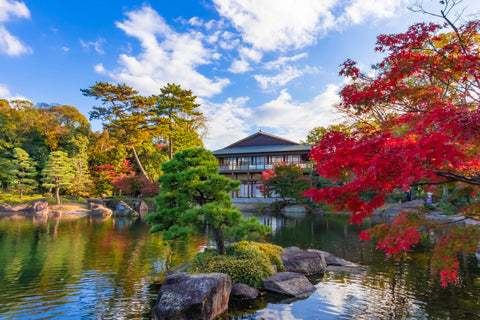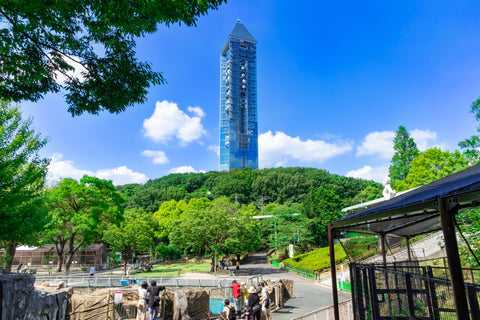
Jump to:
Nagoya, Japan's fourth largest city, is a bustling hub that embodies modern-day Japanese urban life – without the overtourism that’s been plaguing Tokyo, Kyoto and elsewhere in Japan these days.
For most International visitors to the Nagoya area, the most common reasons to be here include the Ghibli Park; the Formula 1 races held every year at nearby Suzuka Circuit; and business activity related to Toyota and other Japanese Auto industry companies.
As a destination, Nagoya has much more than this to offer, of course – granted, this may need to be sought out rather than something one would see right away on social media for example. An overnight trip or a long weekend in Nagoya will offer not only noteworthy sites but some hardy Japanese meals that you are not soon to forget.
In this edition of the Japanese Taste blog, we’ll delve into the sights and experiences of Nagoya Let's explore Japan's fourth largest city – and third-largest metropolitan area.
Nagoya: The Good, The Bad & The Ugly
Admittedly, Nagoya is not often at the top of the destination list for most first time visitors to Japan (or even for some who are making a return visit). But you’re likely to be well rewarded by venturing to Nagoya in your travels to this part of the world.
Let’s dismiss with the possibly bad and potentially ugly, right up front.
Nagoya is (unfairly, we might add) the butt of some jokes for both Japanese people and visitors to Japan. Why? it's a rather easy target, being the Japanese equivalent of a US city such as Detroit or Cleveland. In fact Nagoya and Detroit are sister cities, and that's because they are both home to their country’s auto industries.
Visually speaking, Nagoya is a modern city, noticeably different from the ancient capital of Kyoto. That’s because, unlike Kyoto, Nagoya was not spared bombing during World War II, and in fact suffered heavy damage. The Nagoya Castle that you see today, for example, is a castle that was rebuilt after the war (not unlike many castles in Japan, e.g. Osaka, Hiroshima and others).
Another feature of the Nagoya cityscape is (in perception) a relative lack of noteworthy features, either topographical or even architectural. While Nagoya is located near the ocean and is of course a major port for Japan (most notably for the automobile industry), the city center of Nagoya does not front onto the ocean or even onto a bay or river. There are mountains outside the city, and those are definitely worth exploring as well. In the city, however, you're likely to experience a rather flat and grid-like Urban center.
But none of this should mean that Nagoya is not worth visiting. On the contrary. the fact that it is not Tokyo nor is it Kyoto should actually be a welcoming differentiator. If you're looking for an experience in Japan that shows how Japanese people live day-to-day, without having to encounter the crowds or suffer the severe filter that tourist crowds can bring, Nagoya can be a great opportunity for your Japan visit.
If you're a holder of the Japan Rail pass, Nagoya will be right on your way thanks to the shinkansen bullet train, between Tokyo and Kyoto/Osaka. That makes it an easy stop for the day, an overnight or even more. Even better news: while practically all of those other travelers will stay on the train between Tokyo and Kyoto in one direction or the other, you will get off in relative anonymity and be surrounded by far fewer tourists and thus able to enjoy your travels in Nagoya. No hordes of tourists crowding the narrow streets, no travelers overwhelming the best restaurants to raise your FOMO anxiety even more.
Speaking of narrow streets, one thing that you're likely to encounter in Nagoya is relatively wide streets. That's because the city was largely rebuilt following the second world war, and in doing so the city planners envisioned wider boulevards with more space available.
Enjoy the relatively wide-open environs as you hit some of the top sights that Nagoya has to offer.
Ghibli Park: Where Limitless Fantasy Comes To Life

Just outside Nagoya is Ghibli Park, a captivating realm where the enchanting worlds of Studio Ghibli come to life. This immersive theme park, meticulously crafted to capture the essence of Japan’s beloved Ghibli films, invites visitors of all ages to embark on a magical journey through beloved stories and characters.
Upon entering Ghibli Park, visitors are greeted by the breathtaking sight of Ghibli's Grand Warehouse, a majestic structure that serves as the park's centerpiece. Within its expansive halls, guests can explore a treasure trove of Ghibli memorabilia, including original artwork, animation cells and life-sized recreations of iconic scenes.
Venturing further into the park, visitors encounter Hill of Youth, a tranquil haven inspired by the idyllic landscapes of Ghibli films. Winding paths lead through lush greenery, past whimsical play areas and hidden treasures, capturing the serene charm of the countryside as depicted in Ghibli's animations.
Dondoko Forest, another enchanting area of the park, transports visitors to the magical world of My Neighbor Totoro. A towering replica of Satsuki and Mei's iconic house stands nestled amidst the trees, beckoning visitors to step inside and experience the heartwarming world of the film.
As the sun begins to set, Ghibli Park transforms into a magical spectacle of light and sound. Illuminated displays light up the park's iconic landmarks, while enchanting melodies from Ghibli films fill the air, creating an atmosphere of pure enchantment. From the meticulous attention to detail in each attraction to the immersive storytelling, every aspect of Ghibli Park is designed to transport visitors to the realms of their favorite Ghibli films.
Nagoya Castle: An Updated Icon & City Symbol

Nagoya Castle is an iconic symbol that dates back to the Edo period. Although the castle was rebuilt following the heavy bombing of the Second World War, it offers visitors an easily accessible venture into Japan’s castle scene.
Surrounded by majestic stone walls and vast moats, this architectural marvel showcases traditional Japanese design.
Explore Nagoya Castle's meticulously reconstructed interiors, offering a glimpse into the life of samurais and feudal lords. The picturesque gardens surrounding the castle provide a serene escape, making Nagoya Castle a must-visit for history enthusiasts and admirers of Japanese architecture.
Atsuta Shrine: Where Tradition Meets Tranquility

Atsuta Shrine, one of Japan's most revered Shinto shrines, invites visitors to experience the serenity of spiritual devotion.
The grounds are home to the sacred "Kusanagi-no-Tsurugi," one of the Three Imperial Regalia of Japan.
Wander through the enchanting forested pathways, participate in rituals and soak in the profound sense of peace that permeates this sacred space. Atsuta Shrine offers a cultural immersion that connects visitors with Japan's rich spiritual heritage.
There’s also an outdoor restaurant on the grounds in Atsuta Park, featuring one of Nagoya’s culinary specialties: Kishimen. Enjoy a bowl of this noodle soup (much like udon) in natural surroundings before moving on to your next destination.
Nagoya City Science Museum: Unleashing Curiosity

For those with a penchant for exploration and discovery, the Nagoya City Science Museum stands as a beacon of scientific wonder.
Home to one of the world's largest planetariums, this museum boasts interactive exhibits that make learning about astronomy, technology and the natural world an engaging experience.
From the awe-inspiring giant globe to hands-on experiments, the Nagoya City Science Museum sparks curiosity and ignites a passion for learning in visitors of all ages.
Osu Kannon (Hoshoin): An Oasis Of Tradition

In the heart of Nagoya's bustling urban landscape lies Osu Kannon, a Buddhist temple that exudes tranquility amid the vibrant energy of the city.
Surrounded by quaint shops and narrow alleys, Osu Kannon offers a perfect blend of spiritual reflection and retail therapy.
Visitors can explore the temple grounds, make offerings and then peruse the adjacent Osu shopping district for a taste of traditional Japan. Here you’ll find quaint restaurants, street food stands, stores selling vintage clothing and much more.
Oasis 21: Modernity Beneath The Sky

Oasis 21 is a futuristic complex in central Nagoya that redefines urban spaces.
The highlight is the "Spaceship Aqua," a floating water-filled roof that offers spectacular views of Nagoya Tower and the city skyline.
Beneath this striking structure lies a shopping complex and an underground oasis, complete with restaurants and entertainment options. Oasis 21 encapsulates the Japanese concept of blending innovation with aesthetics.
Hisaya Odori Park: Urban Island of Recreation

Hisaya Odori Park, a sprawling green expanse in the heart of Nagoya, offers a breath of fresh air for locals and tourists alike.
The park hosts seasonal events and festivals, adding vibrancy to the cityscape. The landmark Nagoya TV Tower at one end of the park provides panoramic views of the surroundings, making it an ideal spot for a leisurely stroll or a picnic beneath the open sky.
Tokugawaen: Tranquil Beauty Amidst Nature

Escape the urban hustle and step into the tranquility of Tokugawaen, a traditional Japanese garden that unfolds the beauty of each season.
Stroll along meandering paths. Cross stone bridges. Admire the meticulously manicured landscapes.
The teahouse overlooking the pond provides a serene spot for contemplation, making Tokugawaen a haven for nature enthusiasts seeking a respite from the city buzz.
Higashiyama Sky Tower: Panoramic Perspectives

Ascend to the heights at the Higashiyama Sky Tower, where panoramic views of Nagoya unfold in all directions.
The observation deck provides a fine vantage point, allowing visitors to witness the city's skyline, the distant mountains and the meandering rivers. Sky Tower's design itself is a marvel of modern architecture, seamlessly blending with the urban landscape.
Nagoya Station & Takashimaya: Retail Extravaganza

Arriving or departing by shinkansen (bullet train)?
Indulge in a shopping spree at JR Nagoya Takashimaya, a premier department store that combines luxury brands with traditional Japanese craftsmanship.
From fashion and beauty to gourmet dining, this retail haven caters to discerning shoppers. Immerse yourself in the dynamic energy of Nagoya's commercial district and discover an array of products that showcase the city's unique blend of tradition and modernity.
The entire station complex is a labyrinth of retail and dining pleasures, both above and below ground. Allow some time here before hopping the train onward.
A Rewarding Visit To Nagoya
Nagoya, often overshadowed by its larger counterparts, emerges as a city of hidden treasures and cultural richness.
From the historic allure of Nagoya Castle to the serene landscapes of Tokugawaen, every corner reveals a different facet of this multifaceted city.
Whether you seek spiritual contemplation, scientific exploration or simply the joy of discovering new scenes, Nagoya is worthy of a place on your Japan itinerary.
Don't know what to eat in Nagoya? Check out our top 12 picks.


0 comments